Sarah Sundin's Blog, page 201
November 11, 2018
Today in World War II History—Nov. 11, 1943

Curtiss SB2C Helldiver, 1943-45 (US Navy photo)
75 Years Ago—Nov. 11, 1943: US Navy carrier aircraft & land-based aircraft, plus bombers of the US Fifth & Thirteenth Air Forces and the Royal Australian Air Force (total of over 300 aircraft), make major raid on Japanese base at Rabaul, destroying 55 aircraft.
On Rabaul raid, US Navy Curtiss SB2C Helldiver makes its combat debut.
US Eighth Air Force activates “Carpetbagger” squadrons to deliver supplies to resistance members in Nazi-occupied Europe.

Japanese freighter exploding after being hit by a bomb, Rabaul (public domain via WW2 Database)
November 10, 2018
Today in World War II History—Nov. 10, 1943

US Navy poster with quote from Adm. Alan Kirk, 1944 (US National Archives)
75 Years Ago—Nov. 10, 1943: Soviets break through German lines at Gomel, Byelorussia.
Rear Adm. Alan Kirk assumes command of Western Naval Task Force (US Task Force 122), over US naval forces for Operation Overlord (D-day).
November 9, 2018
Today in World War II History—Nov. 9, 1943

Mother’s Day celebration at a United Nations Relief and Rehabilitation Administration displaced persons camp in Germany, 26 May 1946 (Source: Deutsche Fotothek via Wikimedia Commons, photographer Abraham Pisarek)
75 Years Ago—Nov. 9, 1943: Representatives of 44 nations meet in Atlantic City, NJ, and establish United Nations Relief and Rehabilitation Administration to prepare for reconstruction of Europe & Asia.
US Marines break up Japanese counterattack on Piva Trail on Bougainville.
November 8, 2018
Today in World War II History—Nov. 8, 1943

Flight nurses of the 807th MAETS show their worn-out shoes after their two-month trek through Albania, 9 January 1944 (US Air Force photo)
75 Years Ago—Nov. 8, 1943: US Marines repulse heavy Japanese offensive at Koromokina Lagoon, Bougainville.
US C-53 cargo plane carrying 13 flight nurses & 13 medics of the 807th Medical Air Evacuation Transport Squadron, plus 4 crewmen, crash-lands in Nazi-occupied Albania; over the next two months, they’ll escape on foot back to Allied territory.
November 7, 2018
Today in World War II History—Nov. 7, 1943
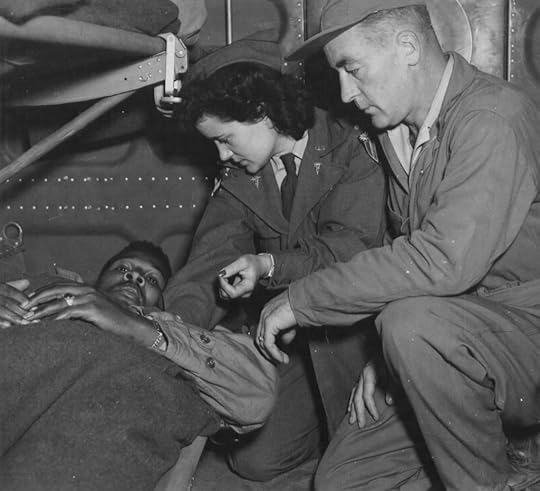
Lt. Pauline Curry & Tech. Sgt. Lewis Marker, 803rd MAETS, check a patient on a flight over India (US Air Force photo)
75 Years Ago—Nov. 7, 1943: US 803rd Medical Air Evacuation Transport Squadron arrives at Chabua, India, and flies its first air evacuation mission.
Release of wartime short film Beyond the Line of Duty, narrated by Ronald Reagan.
November 6, 2018
Today in World War II History—Nov. 6, 1943

Submarine USS Pampanito, San Francisco, CA, October 2014 (Photo: Sarah Sundin)
75 Years Ago—Nov. 6, 1943: Hitler names Field Marshal Albert Kesselring commander of all German forces in Italy, replacing Field Marshal Erwin Rommel, who will be sent to France to prepare defenses along the coast.
Soviets retake Kiev, Ukraine.
Submarine USS Pampanito is commissioned at Portsmouth Navy Yard, NH, now a museum ship in San Francisco.

Gen. Albert Kesselring, 1940 (German Federal Archive: Bild 183-R93434)
November 5, 2018
Medical Air Evacuation in WWII – One Patient’s Journey
 Flight nurse Lt. Georgie Taylor smiled at Private Hawkins, who was recovering from abdominal surgery due to a rifle wound. “We’ll be in Tunisia . . .”
Flight nurse Lt. Georgie Taylor smiled at Private Hawkins, who was recovering from abdominal surgery due to a rifle wound. “We’ll be in Tunisia . . .”
He was too pale. Restless. His hand chilled her. Georgie leaned closer, her mind tingling with concern. “Are you all right?”
“Thirsty.” He rubbed his throat with white fingers.
She wrapped her hand around his wrist to measure his pulse—rapid as she feared. No doubt about it. He was going into shock, probably from postsurgical internal bleeding.
On Distant Shores, p. 55 (Wings of the Nightingale #2)
Before World War II, medical air evacuation was little but theory—by the end of the war, it was recognized as vital to patient care. I enjoyed following the development of air evacuation in my Wings of the Nightingale series, which featured three flight nurses based in the Mediterranean. In this blog series, I’ve discussed general principles of air evacuation. Today we’ll follow one patient’s flight experience, and next week we’ll meet the flight nurse.
Pre-Flight
Let’s follow my fictional patient, Private Hawkins. In the battle for Troina, Sicily in early August 1943, Hawkins is shot in the abdomen. Medics perform first aid and take him from the battlefield to the battalion aid station, where he’s stabilized. An ambulance carries him to a field or evacuation hospital, where he undergoes abdominal surgery. After he’s stabilized, an ambulance takes him to the airfield at Termini Imerese, Sicily, and a C-47 will fly him to the large US hospital complex at Mateur, Tunisia, since he will need a long recuperation. (Read more: Hospitalization in World War II—Evacuation of the Wounded)
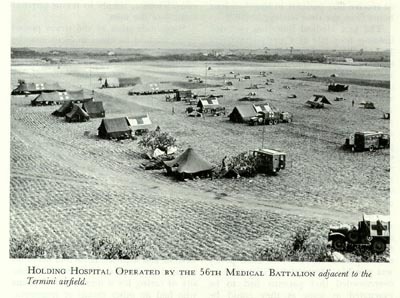
Holding hospital, 56th Medical Battalion, Termini AF, Termini Imerese, Sicily, 1943 (US Army Medical Department, Office of Medical History)
At Termini he arrives at a tent hospital at the airfield. The flight surgeon evaluates the patients to decide which are good candidates for air evacuation. Due to high altitude and unpressurized aircraft cabins, the doctors prefer not to send patients with serious head injuries, sucking chest wounds, or severe anemia. Each combat theater has different policies on “neuropsychiatric” patients, but if they’re allowed, an extra technician attends these patients.

American and Italian wounded at Agrigento, Sicily, await evacuation by plane to Africa for further medical treatment, 25 July 1943 (USAAF photo)
At the airfield holding unit, the physician briefs flight nurse Lt. Georgie Taylor on each patient. Georgie in turn orients the patients—most of whom have never flown—on what to expect. Private Hawkins wears an Emergency Medical Tag (EMT) which summarizes his condition and treatment. A large envelope with his medical records and X-rays rests beside him on the litter.

Flight nurse Verona Savinski, 802nd Medical Evacuation Transport Sqd., and Cpl. Claude W. Thomas 3rd Auxiliary Surgical Group, with Pfc. Joe Kirach of Brooklyn N.Y., 504th Parachute Infantry, Italy, 28 October 1943 (US National Archives)
Loading the Plane
The surgical technician and medics from the holding unit carry the litter patients onto the plane. At the cargo door, Georgie checks the EMT against the list of patients on her flight manifest and directs the tech where to place each patient based on his medical needs.

Flight nurse Lt. Mae Olson takes the name of a wounded American soldier being placed aboard a C-47 for air evacuation from Guadalcanal in 1943 (US Air Force photo)
The litters are clamped into aluminum racks along each side of the fuselage, stacked three litters high. Later versions of the C-47 will come equipped with lightweight web-strapping systems to hold litters. Hawkins is placed in the middle tier for easier access. Lower tiers are reserved for patients with heavy casts or needing more intense care.
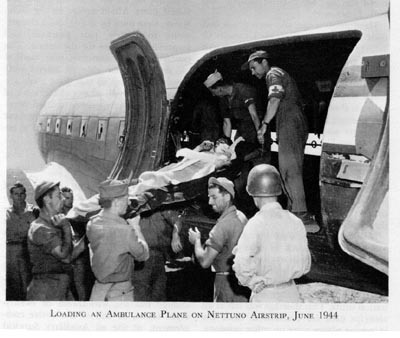
Loading a C-47 for a medical air evacuation flight, Nettuno, Italy, June 1944 (US Army Medical Department, Office of Medical History)
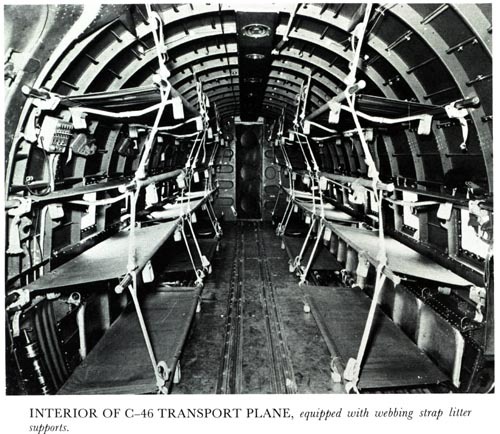
Interior of C-46 transport plane equipped with webbing strap litter supports (US Army Medical Department, Office of Medical History)
Flight
After the patients are secured, the C-47 glides down the runway. When the plane levels off, the flight nurse and technician see to the patients’ needs. They record Hawkins’s “TPR” (temperature, pulse, and respiration) on the flight manifest, and check for signs of bleeding and infection.

Air evacuation team from 803rd Medical Air Evacuation Transportation Squadron, Lt. Pauline Curry and Tech. Sgt. Lewis Marker, check a patient on a flight over India. (US Air Force photo)
The flight team also provides water and food if needed. They converse with the patients, a voice of calm for the anxious and of encouragement for the depressed. If no patients are on oxygen, the men are allowed to smoke.
The interior of the C-47 is poorly ventilated and heated, and becomes stifling in hot weather and frigid in colder climates or higher altitudes. Smells can become overwhelming, especially when burn patients are aboard or someone becomes airsick. Surprisingly, air sickness occurs in less than 1 percent of flights.
Georgie is trained to treat shock, hemorrhage, pain, air sickness, and other medical emergencies. When Private Hawkins goes into shock, Georgie and her technician administer plasma and oxygen to keep him alive.

Lt. Katye Swope of the 802nd Medical Air Evacuation Transport Squadron checks patients being evacuated from Agrigento, Sicily to North Africa for further medical treatment, 25 July 1943. (US Air Force photo)
Unloading
When the C-47 lands at Mateur, Georgie and the technician unload the plane with the help of men on the ground. A trained flight team can unload a full plane in 5-10 minutes, which is crucial in case of crash landing or ditching in water.
Due to Private Hawkins’s condition, he is rushed to the shock ward to be prepared for surgery. He will recover.
Today in World War II History—Nov. 5, 1943

US Navy pilots Ens. Charles Miller, Lt. (jg) Henry Dearing, and Lt. (jg) Bus Alber, USS Saratoga, 5 Nov 1943; note F6F fighter (US National Archives)
75 Years Ago—Nov. 5, 1943: Capt. Clark Gable leaves England, having flown 5 missions with the US Eighth Air Force, with footage for his documentary, Combat America.
In the first US carrier strike on Japanese base of Rabaul, aircraft from USS Saratoga & USS Princeton cripple 7 cruisers and 2 destroyers.

Japanese destroyer Chikuma being bombed by an aircraft from USS Saratoga, 5 Nov 1943 (US National Archives)
November 4, 2018
Today in World War II History—Nov. 4, 1943
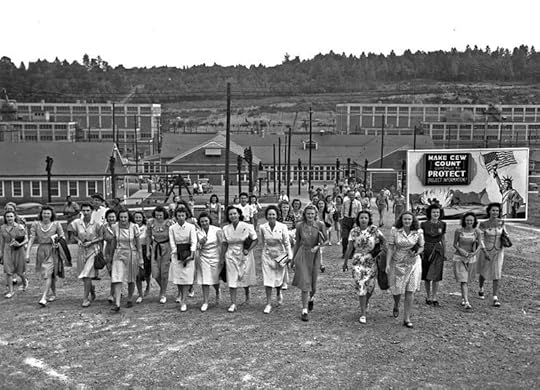
Shift change at the Y-12 uranium enrichment facility in Oak Ridge, Tennessee, during the Manhattan Project, 1945 (US Army photo)
75 Years Ago—Nov. 4, 1943: Plutonium processing plant opens at Oak Ridge, Tennessee, for atomic bomb development.
November 3, 2018
Today in World War II History—Nov. 3, 1943

USS Oklahoma after refloating, Pearl Harbor, 6 Nov 1943 (US Navy photo)
75 Years Ago—Nov. 3, 1943: Battleship USS Oklahoma, sunk at Pearl Harbor, is refloated, but it will be scrapped due to excessive damage.
US Eighth Air Force sends 566 bombers to hit Wilhelmshaven, its first mission of over 500 bombers.
Nazis massacre 18,000 Jewish slave laborers outside Majdanek concentration camp in largest single-day, single-location killing of the Holocaust.
Secretary of the Interior Harold Ickes signs interim agreement with coal miners and full production resumes; total sum of work stoppages during 1943 estimated at 7.5 million man-days and 39 million tons of coal.



